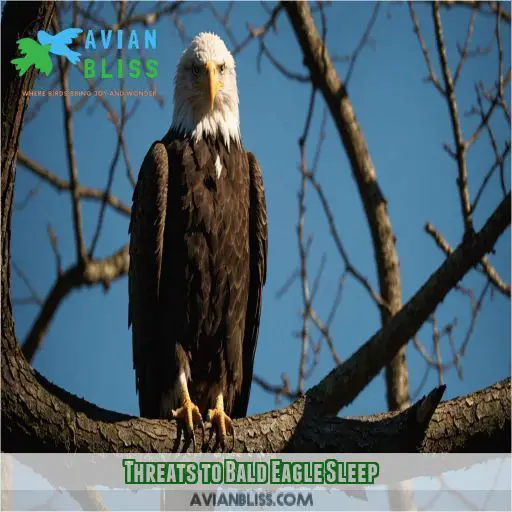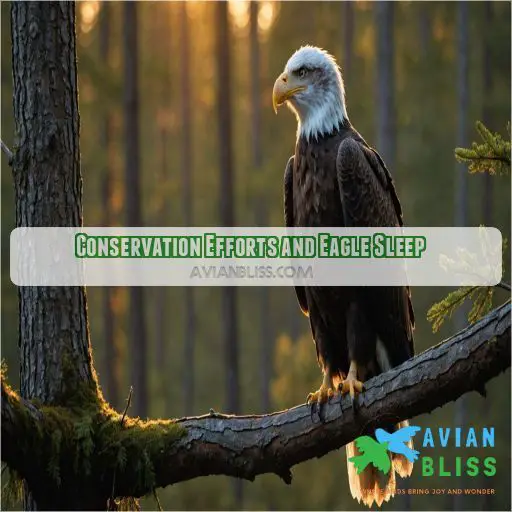This site is supported by our readers. We may earn a commission, at no cost to you, if you purchase through links.
 You’re curious about the sleep habits of America’s majestic birds – the bald eagles!
You’re curious about the sleep habits of America’s majestic birds – the bald eagles!
So, how do Bald Eagles sleep?
These birds don’t exactly follow a traditional sleep schedule.
They snooze at night and take short naps during the day, especially in winter.
In fact, they spend around 10-12 hours per day sleeping, often in a unique position with one leg tucked up and their head turned around, resting on their back.
Thanks to their 7,000 insulating feathers and a special membrane that protects their eyes, they can catch some serious Z’s.
But there’s more to their sleep story…
Table Of Contents
- Key Takeaways
- Bald Eagle Sleep Patterns
- Eagle Roosting Behavior
- Physical Characteristics for Sleep
- Threats to Bald Eagle Sleep
- Conservation Efforts and Eagle Sleep
- Frequently Asked Questions (FAQs)
- Does a bald eagle sleep?
- Do eagles sleep with their eyes closed?
- What position do eagles sleep in?
- Are bald eagles active at night?
- Do bald eagles sleep with their eyes open always?
- Can bald eagles fly immediately after waking up?
- How long do bald eagles sleep during winter months?
- Do bald eagles sleep more during breeding season or not?
- Can bald eagles sleep while perched on power poles safely?
- Conclusion
Key Takeaways
- You’ll be surprised to learn that bald eagles sleep for around 10-12 hours a day, with most of their sleeping happening at night, and they also take short naps during the day, especially in winter.
- Bald eagles sleep in a unique position, perched on branches with one leg tucked up and their head turned around, resting on their back, and their special feathers and eyelids help them catch some serious sleep.
- These birds gather in communal roosts, often in large trees, to roost together, and this social behavior helps them conserve energy, protect themselves from harsh weather and predators, and even strengthen their bonds with other eagles.
- Unfortunately, human activities like habitat loss, light pollution, and climate change can disrupt bald eagles’ sleep patterns, and conservation efforts are necessary to protect their roosting habits and habitats, so we can help these majestic birds get some quality rest.
Bald Eagle Sleep Patterns
You’re about to get up close and personal with America’s majestic birds, exploring one of the most intriguing aspects of their behavior: sleep patterns. As you learn about bald eagle sleep habits, you’ll discover some surprising facts that will change the way you think about these incredible creatures.
Do Bald Eagles Sleep at Night?
You’re curious about bald eagles’ sleep habits? Well, it turns out they don’t exactly follow a traditional sleep schedule. Bald eagles do sleep at night, but they also take short naps during the day, especially in winter. Their sleep cycle is adapted to conserve energy.
How Many Hours Do Bald Eagles Sleep?
As you wonder how many hours bald eagles sleep, research suggests they spend around 10-12 hours per day resting or sleeping, with most of their snoozing happening at night. Their sleep cycle is adapted to their roosting time, ensuring they’re well-rested for hunting and survival.
Do Bald Eagles Sleep With Their Eyes Closed?
As you wonder if bald eagles sleep with their eyes closed, you’re not alone! Unlike humans, eagles have a special membrane that protects their eyes during sleep, called the nictitating membrane. This third eyelid shields their peepers, allowing them to snooze with eyes partially open.
What Position Do Bald Eagles Sleep In?
When it’s time to snooze, bald eagles sleep in a unique position. They perch on branches, often with one leg tucked up, and their head turned around, resting on their back . This special sleep position helps them balance and rest while still being alert to their surroundings.
- Imagine a majestic bald eagle perched high on a branch, its sharp talons gripping the wood, and its soft feathers ruffled by the wind.
- Picture the eagle’s head tucked under its wing, its beak pointing downwards, and its piercing eyes closed in a peaceful slumber.
- Envision the eagle’s body swaying gently in the breeze, its wings folded against its back, and its tail feathers spread wide for balance.
Eagle Roosting Behavior
You’re probably curious about how bald eagles catch some Z’s – after all, they’re not exactly known for their bedtime routines. Let’s explore the fascinating world of eagle roosting behavior, where these majestic birds gather in communal roosts to snooze the night away.
What is Communal Roosting in Bald Eagles?
You’re curious about communal roosting in bald eagles! Imagine a giant slumber party in the sky. Communal roosting is when multiple eagles gather in a single location, often in large trees, to roost together . These roosts are usually near food sources and offer shelter from harsh winds (Source). Roost site selection is essential for the eagles’ survival, especially during winter (Source).
Why Do Bald Eagles Gather in Communal Roosts?
You’re probably wondering why bald eagles gather in communal roosts. It’s all about safety, communication, and socialization! These birds congregate in large trees to protect themselves from harsh weather and predators . Communal roosts also serve as a hub for pair bonding and communication among eagles . It’s like a big eagle social club, where they can mingle and strengthen their bonds .
How Do Communal Roosts Support Bald Eagle Survival?
As you learn about bald eagles, you’ll discover that communal roosts play a key role in their survival. These gatherings provide roosting safety, predator defense, and energy conservation . Social bonding and food sharing also occur, strengthening the eagles’ community . By roosting together, bald eagles can focus on rest and rejuvenation, ensuring their majestic presence continues to thrive.
Physical Characteristics for Sleep
You’re about to discover how bald eagles’ amazing physical traits help them catch some serious Z’s. From their hollow bones to their fantastic feathers, you’ll learn how these birds’ bodies are perfectly adapted for a good night’s sleep – and it’s pretty cool!
How Do Bald Eagles’ Physical Traits Affect Sleep?
As you explore how bald eagles sleep, you’ll discover that their physical traits play a significant role. Their 7,000 feathers provide excellent insulation, keeping them warm in freezing temperatures. Their hooked beak shape and powerful talons also help them settle in for a comfortable night’s rest. Even their exceptional vision isn’t necessary when it’s time to snooze.
The Role of Hollow Bones in Bald Eagle Sleep
As you explore the physical traits that help bald eagles sleep, let’s talk about their hollow bones. This unique feature plays a key role in their ability to rest. Here are three ways hollow bones support eagle sleep:
- Weight distribution: Hollow bones reduce the eagle’s overall weight, making it easier to roost comfortably.
- Bone strength: Despite being hollow, eagle bones are incredibly strong, providing support and protection during rest.
- Energy conservation: Lighter bones conserve energy, allowing eagles to focus on more important things… like sleeping!
How Do Bald Eagles’ Feathers Support Sleep?
You’re probably wondering how bald eagles’ feathers help them catch some Z’s. Well, their 7,000 feathers provide excellent insulation, keeping them warm and cozy even in freezing temperatures. Plus, their feathers offer great wind protection, allowing them to sleep with their wings tucked in, reducing wind resistance. This clever sleep position helps them conserve energy and snooze soundly.
Threats to Bald Eagle Sleep
You’re about to discover the not-so-peaceful side of bald eagle sleep, where human activities, lead poisoning, and climate change come into play. As you explore these threats, you’ll learn how human actions can disrupt the majestic birds’ beauty sleep, and what conservation efforts are being made to help them get a good night’s rest.
How Human Activities Affect Bald Eagle Sleep
You’re probably aware that human activities can disrupt your own sleep, but have you ever considered how they affect bald eagles? Habitat loss, light pollution, and noise pollution from wind turbines can all disturb their roosting habits. Even pesticide use can alter the food chain, making it harder for eagles to catch a good night’s sleep.
The Impact of Lead Poisoning on Bald Eagle Sleep
When you learn about bald eagles, you’ll find that lead poisoning is a serious threat to their sleep and overall health. When eagles ingest lead, it disrupts their sleep patterns, causing behavioral changes and impacting their daily routines. Conservation efforts are underway to reduce lead poisoning, but it’s really important to address this issue to protect eagle health and well-being.
How Climate Change Affects Bald Eagle Roosting Behavior
You’re about to discover how climate change affects bald eagle roosting behavior. As winters get warmer, their roosting sites are shifting . Changes in food availability, like salmon spawning patterns, also impact their roosting habits . This means they’re adapting their migration patterns and nest site selection to cope with the changing climate .
Conservation Efforts and Eagle Sleep
Now that we’ve explored the threats to bald eagle sleep, let’s talk about the heroes of the story: conservation efforts. By protecting roosts, reducing human impact, and preserving habitats, we can help these majestic birds catch some quality Z’s. Here are a few ways we’re making a difference:
- Protecting roosts from human disturbance to minimize sleep disturbances
- Preserving habitats to create a safe place to snooze
- Reducing lead poisoning to promote overall health
- Supporting conservation gains through responsible human behavior
Frequently Asked Questions (FAQs)
Does a bald eagle sleep?
Can you imagine soaring through the skies all day and still getting a good night’s sleep? Bald eagles do! They sleep with their eyes open, keeping watch for predators, and take turns resting in communal roosts.
Do eagles sleep with their eyes closed?
You’re curious about eagles’ sleep habits! Yes, bald eagles do sleep with their eyes closed, thanks to their specialized eyelids and nictitating membrane, which helps keep their eyes moist and clean .
What position do eagles sleep in?
Perched in a sweet slumber, eagles snooze in an upright position, often with their feathers fluffed up for warmth. You’ll rarely catch them lying down, as they prefer to rest while still being partially alert.
Are bald eagles active at night?
You’re wondering if bald eagles are active at night? Actually, they’re primarily diurnal birds, meaning they’re most active during the day . However, they might occasionally engage in some nocturnal behaviors, like scavenging or flying under moonlight .
Do bald eagles sleep with their eyes open always?
Did you know that bald eagles can sleep for around 10-12 hours a day? You might wonder, do bald eagles sleep with their eyes open always? Actually, they can sleep with one eye open, thanks to unihemispheric slow-wave sleep (Source).
Can bald eagles fly immediately after waking up?
You’re wondering if bald eagles can take to the skies immediately after waking up?
Well, you’re in luck! Bald eagles can indeed fly right away, thanks to their unique physiology.
Their feathers, hollow bones, and powerful talons make flight possible at a moment’s notice.
How long do bald eagles sleep during winter months?
You’re curious about bald eagles’ winter sleep patterns! During the cold months, they typically snooze for 8-12 hours, often in communal roosts with fellow eagles, taking turns keeping watch for potential threats while the others catch some Z’s.
Do bald eagles sleep more during breeding season or not?
You’re curious about bald eagles’ sleep habits during breeding season. It’s actually pretty surprising that they sleep less during this time, devoting around 4-5 hours to rest . Their parental duties keep them busy, ensuring their young ones thrive.
Can bald eagles sleep while perched on power poles safely?
You’re wondering if bald eagles can snooze safely on power poles? Actually, they can, thanks to their insulating feathers and careful perching . Just like a hot air balloon, they remain safe as long as they don’t touch another wire or a grounded object .
Conclusion
Bald eagles are true sleep aficionados, spending 10-12 hours snoozing each day.
They sleep with one leg tucked up and their head turned around.
Understanding their sleep patterns is key to preserving their roosting habits and habitats.
This is important as we aim to protect America’s majestic birds.








